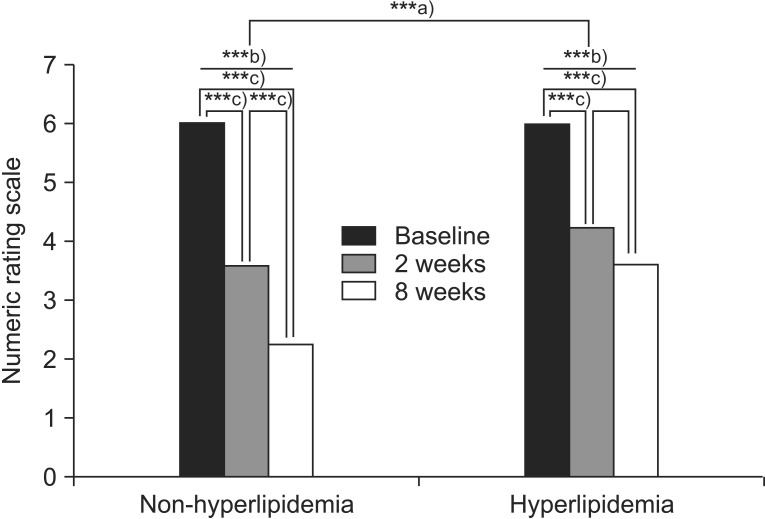Ann Rehabil Med.
2016 Jun;40(3):463-469. 10.5535/arm.2016.40.3.463.
Influence of Hyperlipidemia on the Treatment of Supraspinatus Tendinopathy With or Without Tear
- Affiliations
-
- 1Department of Rehabilitation, Incheon St. Mary's Hospital, College of Medicine, The Catholic University of Korea, Incheon, Korea. jung024@hanmail.net
- KMID: 2327608
- DOI: http://doi.org/10.5535/arm.2016.40.3.463
Abstract
OBJECTIVE
To investigate the influence of hyperlipidemia on the treatment of supraspinatus tendinopathy, with or without tear.
METHODS
We retrospectively reviewed the data of patients with shoulder pain and patients with supraspinatus tendinopathy, with or without tear, were included in the study. Exclusion criteria were prior shoulder surgery, prior steroid injection, neurological diseases that could lead to shoulder pain, and use of lipid-lowering medication. According to the serum lipid profiles, patients were assigned to either the hyperlipidemia or non-hyperlipidemia group. By analyzing the numeric rating scale (NRS) before treatment, and at 2 weeks and 8 weeks after treatment, we compared the difference in treatment effect between the two groups.
RESULTS
No significant baseline difference was found among the two groups for age, gender, body mass index, duration of pain, side of pain, range of motion of affected shoulder, or physical examination. On the repeated-measures analysis of variance, NRS scores significantly decreased with time for both groups (p<0.001). When analyzing the effect of time between the subjects factor, there was significant difference in the treatment effect between the two groups (p<0.001), namely NRS was less decreased in the hyperlipidemia group.
CONCLUSION
We found that hyperlipidemia may be an adversely affecting factor in the treatment of supraspinatus tendinopathy with or without tear.
Keyword
MeSH Terms
Figure
Reference
-
1. Seitz AL, McClure PW, Finucane S, Boardman ND 3rd, Michener LA. Mechanisms of rotator cuff tendinopathy: intrinsic, extrinsic, or both? Clin Biomech (Bristol, Avon). 2011; 26:1–12.
Article2. Nho SJ, Yadav H, Shindle MK, Macgillivray JD. Rotator cuff degeneration: etiology and pathogenesis. Am J Sports Med. 2008; 36:987–993. PMID: 18413681.3. Via AG, De Cupis M, Spoliti M, Oliva F. Clinical and biological aspects of rotator cuff tears. Muscles Ligaments Tendons J. 2013; 3:70–79. PMID: 23888289.
Article4. Titchener AG, White JJ, Hinchliffe SR, Tambe AA, Hubbard RB, Clark DI. Comorbidities in rotator cuff disease: a case-control study. J Shoulder Elbow Surg. 2014; 23:1282–1288. PMID: 24618192.
Article5. Mall NA, Tanaka MJ, Choi LS, Paletta GA Jr. Factors affecting rotator cuff healing. J Bone Joint Surg Am. 2014; 96:778–788. PMID: 24806015.
Article6. Abboud JA, Kim JS. The effect of hypercholesterolemia on rotator cuff disease. Clin Orthop Relat Res. 2010; 468:1493–1497. PMID: 19885710.
Article7. Beason DP, Tucker JJ, Lee CS, Edelstein L, Abboud JA, Soslowsky LJ. Rat rotator cuff tendon-to-bone healing properties are adversely affected by hypercholesterolemia. J Shoulder Elbow Surg. 2014; 23:867–872. PMID: 24295837.
Article8. Beason DP, Hsu JE, Marshall SM, McDaniel AL, Temel RE, Abboud JA, et al. Hypercholesterolemia increases supraspinatus tendon stiffness and elastic modulus across multiple species. J Shoulder Elbow Surg. 2013; 22:681–686. PMID: 22981355.
Article9. Bretzke CA, Crass JR, Craig EV, Feinberg SB. Ultrasonography of the rotator cuff: normal and pathologic anatomy. Invest Radiol. 1985; 20:311–315. PMID: 3897119.
Article10. Jellinger PS, Smith DA, Mehta AE, Ganda O, Handelsman Y, Rodbard HW, et al. American association of clinical endocrinologists' guidelines for management of dyslipidemia and prevention of atherosclerosis. Endocr Pract. 2012; 18(Suppl 1):1–78. PMID: 22522068.
Article11. Hjermstad MJ, Fayers PM, Haugen DF, Caraceni A, Hanks GW, Loge JH, et al. Studies comparing numerical rating scales, verbal rating scales, and visual analogue scales for assessment of pain intensity in adults: a systematic literature review. J Pain Symptom Manage. 2011; 41:1073–1093. PMID: 21621130.
Article12. Abate M, Schiavone C, Salini V. Sonographic evaluation of the shoulder in asymptomatic elderly subjects with diabetes. BMC Musculoskelet Disord. 2010; 11:278. PMID: 21138564.
Article13. Clement ND, Hallett A, MacDonald D, Howie C, McBirnie J. Does diabetes affect outcome after arthroscopic repair of the rotator cuff? J Bone Joint Surg Br. 2010; 92:1112–1117. PMID: 20675756.
Article14. Beason DP, Abboud JA, Kuntz AF, Bassora R, Soslowsky LJ. Cumulative effects of hypercholesterolemia on tendon biomechanics in a mouse model. J Orthop Res. 2011; 29:380–383. PMID: 20939036.
Article15. Kuriyama M, Fujiyama J, Yoshidome H, Takenaga S, Matsumuro K, Kasama T, et al. Cerebrotendinous xanthomatosis: clinical and biochemical evaluation of eight patients and review of the literature. J Neurol Sci. 1991; 102:225–232. PMID: 2072121.
Article16. Klemp P, Halland AM, Majoos FL, Steyn K. Musculoskeletal manifestations in hyperlipidaemia: a controlled study. Ann Rheum Dis. 1993; 52:44–48. PMID: 8427513.
Article17. von Bahr S, Movin T, Papadogiannakis N, Pikuleva I, Ronnow P, Diczfalusy U, et al. Mechanism of accumulation of cholesterol and cholestanol in tendons and the role of sterol 27-hydroxylase (CYP27A1). Arterioscler Thromb Vasc Biol. 2002; 22:1129–1135. PMID: 12117727.
Article18. Ozgurtas T, Yildiz C, Serdar M, Atesalp S, Kutluay T. Is high concentration of serum lipids a risk factor for Achilles tendon rupture? Clin Chim Acta. 2003; 331:25–28. PMID: 12691860.
Article19. Lewis JS, Sandford FM. Rotator cuff tendinopathy: is there a role for polyunsaturated fatty acids and antioxidants? J Hand Ther. 2009; 22:49–55. PMID: 18950988.
Article20. Mavrogenis S, Johannessen E, Jensen P, Sindberg C. The effect of essential fatty acids and antioxidants combined with physiotherapy treatment in recreational athletes with chronic tendon disorders: a randomised, double-blind, placebo-controlled study. Phys Ther Sport. 2004; 5:194–199.
- Full Text Links
- Actions
-
Cited
- CITED
-
- Close
- Share
- Similar articles
-
- Ultrasonographic Findings in Breast Cancer Patient with Shoulder Pain after Mastectomy
- Intramuscular Lipoma of the Supraspinatus Muscle with Supraspinatus Tendon Partial Tear
- Diagnosis of Partial Thickness Tear of Supraspinatus Tendon Using Dynamic Ultrasonography Under Resisted Scaption Position
- Plain Radiographic Findings of a Supraspinatus Tear: Correlation with MR Findings
- Ultrasonographic Findings of Epicondylitis


